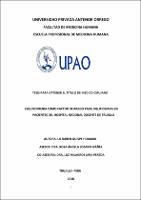| dc.contributor.advisor | Lozano Ibañez, Rosa Angela | |
| dc.contributor.author | Quispe Huaman, Liz Karen | |
| dc.creator | Quispe Huaman, Liz Karen | |
| dc.date.accessioned | 2018-09-07T14:07:13Z | |
| dc.date.available | 2018-09-07T14:07:13Z | |
| dc.date.issued | 2018 | |
| dc.identifier.uri | https://hdl.handle.net/20.500.12759/4279 | |
| dc.description.abstract | Objetivo: Demostrar si la esquizofrenia es un factor de riesgo para dislipidemias en
pacientes mayores de 15 años del Hospital Regional Docente de Trujillo en el período
enero 2013 – diciembre 2017.
Material y Métodos: Se realizó un estudio en el HRDT de diseño observacional,
analítico, retrospectivo, de cohorte en el período enero 20013 – diciembre 2017.
Incluyéndose un total de 159 pacientes quienes se dividieron en 2 grupos: 53 con
esquizofrenia (expuestos) y 106 sin esquizofrenia (no expuestos), se halló la asociación
la asociación usando el Riesgo Relativo y se empleó la Prueba Exacta de Fisher para
hallar la significancia estadística con un p < 0.05.
Resultados: Las edades promedio de los pacientes con y sin dislipidemias fue 37.3 +(8.47)
años y 43.8 +-(9.17) años respectivamente, encontrándose una diferencia
significativa con un p= 0,001. En cuanto al grupo de pacientes con dislipidemias, se
encontró en el género masculino 73% y en el femenino 27% y en cuanto al grupo de
pacientes sin dislipidemias, se encontró en el género masculino 41% y en el femenino
59%. Así mismo, en la obesidad y diabetes mellitus fue significativamente mayor en el
grupo de pacientes con dislipidemias que en el grupo de pacientes sin dislipidemias y en
la hipertensión arterial la frecuencia fue mayor en el grupo de pacientes sin dislipidemias
que en el grupo de pacientes con dislipidemias. Así mismo, la obesidad, la diabetes
mellitus e hipertensión arterial se asoció a dislipidemias con una p<0.05. No se
apreciaron diferencias significativas en relación a las variables tiempo de enfermedad,
procedencia y anemia entre los grupos de estudio (Tabla 1). En los pacientes con
esquizofrenia la frecuencia de dislipidemia fue de 38% y en los pacientes sin
esquizofrenia fue 9%. Al comparar el promedio de las frecuencias de dislipidemias se
encontró una diferencia significativa, con un RR=4, IC al 95% 2.02 a 7.93, p=0.001
(Tabla 2).
Conclusión: La presencia de esquizofrenia es un factor de riesgo para dislipidemias en
pacientes mayores de 15 años del Hospital Regional Docente de Trujillo. | es_PE |
| dc.description.abstract | Objective: To demonstrate if schizophrenia is a risk factor for dyslipidemias in patients
older than 15 years of the Regional Teaching Hospital of Trujillo in the period January
2013 - December 2017.
Material and Methods: A study was conducted in the HRDT of observational,
analytical, retrospective, cohort design in the period January 20013 - December 2017.
Including a total of 159 patients who were divided into 2 groups: 53 with schizophrenia
(exposed) and 106 without schizophrenia (not exposed), the association was found using
the Relative Risk Association and Fisher's Exact Test was used to find the statistical
significance with p <0.05.
Results: The mean ages of the patients with and without dyslipidemias were 37.3 + -
(8.47) years and 43.8 + - (9.17) years respectively, finding a significant difference with a
p = 0.001. Regarding the group of patients with dyslipidemias, 73% were found in the
male gender and 27% in the female gender, and 41% in the male gender and 59% in the
female group without dyslipidemia. Likewise, in obesity and diabetes mellitus it was
significantly higher in the group of patients with dyslipidemias than in the group of
patients without dyslipidemias and in hypertension the frequency was higher in the group
of patients without dyslipidemia than in the group of patients with dyslipidemias.
Likewise, obesity, diabetes mellitus and hypertension were associated with dyslipidemias
with p <0.05. No significant differences were observed in relation to the variables time
of illness, origin and anemia between the study groups (Table 1). In patients with
schizophrenia the frequency of dyslipidemia was 38% and in patients without
schizophrenia it was 9%. When comparing the average of the dyslipidemia frequencies,
a significant difference was found, with a RR = 4, 95% CI 2.02 to 7.93, p = 0.001 (Table
2).
Conclusion: The presence of schizophrenia is a risk factor for dyslipidemias in patients
older than 15 years of the Regional Teaching Hospital of Trujillo. | en_US |
| dc.description.uri | Tesis | es_PE |
| dc.format | application/pdf | es_PE |
| dc.language.iso | spa | es_PE |
| dc.publisher | Universidad Privada Antenor Orrego - UPAO | es_PE |
| dc.relation.ispartofseries | T_MED.HUMA_2409 | |
| dc.rights | info:eu-repo/semantics/openAccess | es_PE |
| dc.source | Universidad Privada Antenor Orrego | es_PE |
| dc.source | Repositorio Institucional - UPAO | es_PE |
| dc.subject | Esquizofrenia | es_PE |
| dc.subject | Dislipidemias | es_PE |
| dc.title | Esquizofrenia como factor de riesgo para dislipidemias en pacientes del Hospital Regional Docente de Trujillo | es_PE |
| dc.type | info:eu-repo/semantics/bachelorThesis | es_PE |
| thesis.degree.level | Título Profesional | es_PE |
| thesis.degree.grantor | Universidad Privada Antenor Orrego. Facultad de Medicina Humana | es_PE |
| thesis.degree.name | Médico Cirujano | es_PE |
| thesis.degree.discipline | Medicina Humana | es_PE |

